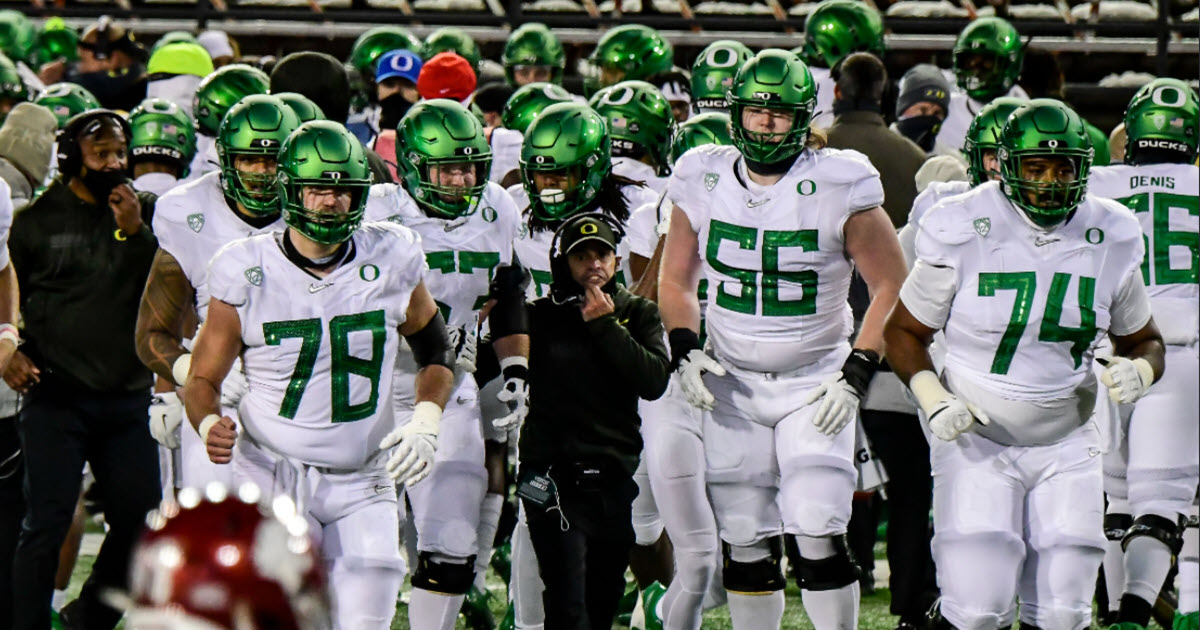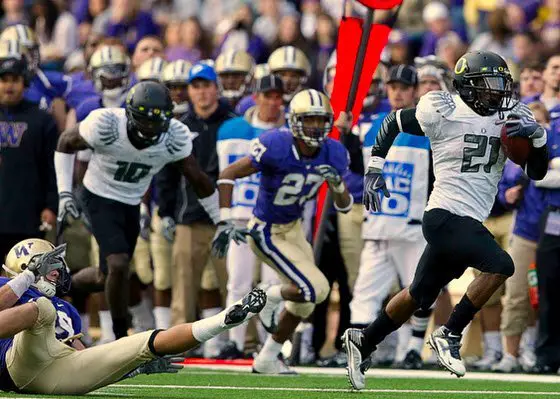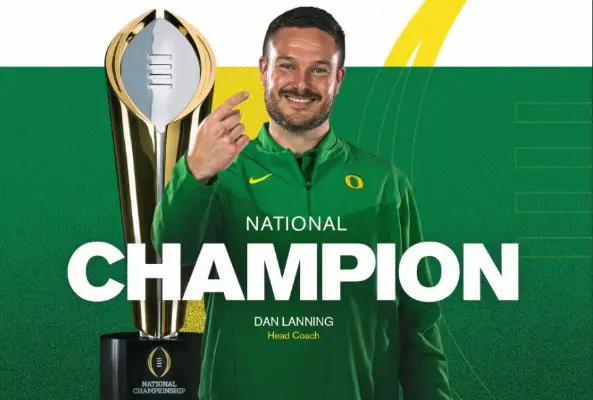Finish your profile right here and directions for adding your Profile Picture (which appears when you post) is right here.

Everything posted by Charles Fischer
-
Did Anyone Go to the Saturday Night Live at Autzen?
Some good stuff in this thread by the indomitable Steven A.!
-
Da’Saahn Brame Flips to Tennessee
Yep. Welcome to the World of Big-Boy football. Note that Oregon has missed on TEs who were not low-rated 3-Stars, but on some of the best in the nation. Three observations... --It is a long way to December...Dano has plenty of time to pivot or flip back, and he will get his. --Oregon has done well in the portal before, and there might be some solutions there as a Band-Aid. --I forgot to mention in my previous analysis articles about the Spring Game that a Walk-on Tight End Freshman, No. 85 who was very impressive to me. He made a tough catch over the middle, but I did not notice that until I was watching the game a second time, and keeping my eye out for him. In my first game view, he was OUTSTANDING at blocking both at the LOS, but also sealing the perimeter from a stance as an H-Back. I was just telling a Duck-Buddy on the phone to watch out for this guy... SIDEARM Integrations GODUCKS.COM Travis Brashear (85) Tight End - As A Freshman (2023) Did not see the field for the Ducks, utilizing a redshirt. He doesn't appear to be small either! (We've had walk-ons break into starting when they got their shot...)
-
QUACKKK, Tradarian Ball Chooses Ducks
-
QUACKKK, Tradarian Ball Chooses Ducks
How the No. 2 Running Back in the nation is only a 4-Star? Oh well, besides Oregon he had other offers from Michigan, Oklahoma, Penn State, Texas, LSU and Georgia. Tradarian Ball | DuckSportsAuthority N.RIVALS.COM Tradarian Ball - 2026 4 Star Running back for Texas (Texarkana, TX) on Rivals.com
-
QUACKKK, Tradarian Ball Chooses Ducks
From Saturday Night Live....and he is the No. 2 running back in the nation? This is the kind of guy that ends up at Georgia, Ohio State, or Alabama....and he's going to be a Duck! We had trouble with RB recruiting in the past, but with Rashaad Samples at RB coach...now we don't! And...he can catch the ball, of which is crucial for our offense!
-
Even Beavis Fans Don't Want Civil War
Beavis taking 30 million from Oregon should not be rewarded for his behavior.
-
Why Dan Lanning Will Have a No. 1 Recruiting Class...
Gentlemen, please read posts closer, as at the beginning of the thread....I did not say THIS YEAR. We have a shot at it in the future when recruits can see that we are competing for 'Nattys, and they like Danno over the other major head coaches. But first we have to prove it on the field.
-
Why Dan Lanning Will Have a No. 1 Recruiting Class...
Not this year, but if Oregon finishes in the Playoff Semi-finals or better this year? Look out in future years! You read the article by a hard-core Trojan writer below, (See Holy Crap! thread) and when even our biggest adversaries are noticing what we see about Lanning...the last domino to fall for a No. 1 recruiting class is showing the CFB world that we, indeed, are in the elite. It is remarkable how well Lanning has done considering our results, and players are comfortable and attracted to him. I really believe that if we have a fantastic year in 2024? We could beat Ryan Day and Kirby Smart....or I should say that Dan Lanning will be more attractive to recruits than the aforementioned. This is why I don't sweat it too much, as I have confidence in the future. Now let's have a great year and finish that domino! Come to Oregon!
-
Josiah Sharma Flips to Texas
Good for you. For some of us...it is part of the overall Oregon entertainment experience. In the end...we'll be fine.
-
Holy Crap! TROJANS Sold on Dan Lanning?
Might this be a little "cover" for Lincoln Riley and his recruiting?
-
Holy Crap! TROJANS Sold on Dan Lanning?
This was posted in another thread, but it illustrates how our opponents are beginning to realize what we now know about Dan Lanning... "..the instructive part of watching Dan Lanning at Big Ten media days is that he acted like the big dog, the alpha male, the skullcrusher who insists on excellence and dominance." Whew! I'm an Oregon fan who would be reluctant to write such masculine stuff about my own coach! Dan Lanning walks tall for Oregon at Big Ten media days TROJANSWIRE.USATODAY.COM Dan Lanning showed why he’s a recruiting juggernaut. "Lanning underscores the point that if Oregon was still coached by Willie Taggart or Mark Helfrich, it would not be recruiting or portaling at such an elite level."
-
Josiah Sharma Flips to Texas
Danno will get his...
-
Josiah Sharma Flips to Texas
So much for our massive NIL advantage!
-
Dan Lanning About Unlimited NIL at Oregon: 'Not a Reality'
The REAL problem DeShaun? Dan Lanning is....
-
Dan Lanning About Unlimited NIL at Oregon: 'Not a Reality'
Lanning responded to a question about operating with an unlimited NIL budget. "What player WOULD we miss on if we had that? This is not realistic."
-
Dan Lanning About Unlimited NIL at Oregon: 'Not a Reality'
"There's not a top 10 program in the nation that is not funded and in a good position to compete or they wouldn't be a top 10 program," he said. "That being said, there are a lot of other factors that add up to that success. "I really don't care what people think. I just want to win. I know the reality of what our situation is here." Dan Lanning dismisses 'unlimited NIL' rumors as 'not living in the real world' 247SPORTS.COM Oregon coach Dan Lanning disputes that Phil Knight has ever said 'unlimited NIL' is available to Duck recruiting. Duck-Buddies...I think this is GOOD to come up and deal with it.
-
Neuheisel: Still a Jerk After All These Years
-
B1G Media Day: Not a Great Start for UCLA
Agreed. I was cocky for years with public speaking, and once had an inexplicable brain freeze and was quite embarrassed. I learned my lesson, and from that point on, always had a list of bullet points to discuss that I could always turn to. The confidence of just having it there made me confident to where I never had to even look at them. But it’s always smart to have a back up. if he is not an experienced public speaker, then he absolutely should’ve been prepared, as a performance like that brings real doubt to the boosters, especially considering he was not a top level selection as a head coach.
-
Kirk Herbstreit: "I May Have Oregon Winning It All"
Kirk has not always been kind to us, but I do enjoy his takes, and love it when he is with us.... Kirk Herbstreit: "I May Have Oregon Winning it All" - On3 WWW.ON3.COM Earlier today college football senior analyst Kirk Herbstreit was on the Pat McAfee show and dropped a big bomb for Oregon fans.
-
B1G Media Day: Not a Great Start for UCLA
You said it...if I was a Bruin, I'd be pretty embarrassed...
-
B1G Duck Invades Indianapolis
THAT above, is the quote of the week.
-
B1G Duck Invades Indianapolis
Interesting what the B1G Commissioner said below... "Our digital presence has been rebuilt and is growing, with more than 800 million impressions, twice as many engagements, and a 220% increase in video views over the last 12 months." So great to join a conference that is growing, and not fading or fighting for relevance.
-
B1G Duck Invades Indianapolis
This was in another thread, but deserves its own. So cool, and this marketing that MATTERS; the Duck is making a splash into the B1G! Like Oregon or hate us,....you're going to know we're HERE!
-
Now That the Ducks are in the Big10, and the Stupid Pac-12 Ban No Longer Applies...
Unknown, but doubt it.
-
BIG Ten Media Day News
Lovely, just lovely. So if one of the west coast teams make it--the fans are at a huge travel disadvantage? Hopefully it will not matter in the future, as I think conference championship games should be eliminated, now that we have a Playoff. (And that should go to 16 teams)















